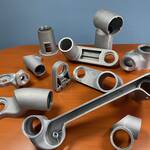Aluminium casting techniques and processes
First of all, we have made choices about the aluminium casting techniques and processes used by our company.
As a result, our company uses these 4 manufacturing methods in order to guarantee you 100% expertise.
LOR ALU has a duty to supply you with parts efficiently and professionally.

Prototyping
Entrust us with your aluminium prototypes to guarantee the success of your projects!

Gripping sand
We produce your parts in small series, whatever their shape or complexity.

Greensand
With this process, small series production will be a major asset for your company.

Shell foundry
Mass production in a metal mould means you can guarantee the quantity you need.
To begin with, this manufacturing process enables a 3D printing mould to be made from sand bonded with a hardening binder.
The prototype mould is then filled with molten metal.
What’s more, modifications to the part can be made very quickly. Using this casting technique means that a project can be validated before it goes into series production.
- Fast
- Reactive
- Modifiable
- Complex shapes
In this process, an impression is made using sand bonded with a hardening binder (resin).
The model (in a box) is generally made of resin or wood. It is filled with sand. It needs time to harden.
The mould is closed, and molten aluminium is poured inside to fill the space left by the model. The mould is then broken and the aluminium piece recovered.
- Large aluminium part
- Complex shapes
- Fine details
This method of casting is similar to sand setting, but uses unhardened green sand and a little clay to form the mould.
The term “green” refers to the fact that the sand is still wet when the mould is made.
This manufacturing process is therefore used for repetitive series of more or less complex shapes with smaller dimensions than those of set sand.
- fast
- series
- less expensive in terms of piece price
In this casting technique, a shell-shaped metal mould is made using a suitable material (usually steel).
The aluminium is then poured into the cavity of the metal mould to make room for the shape of the part.
Finally, the tooling is opened and the sprue recovered. Finishing is then carried out using saws and grinding wheels.
- Repetitive series
- small dimensions
- Attractive part cost
- Good dimensional tolerances on as-cast material
